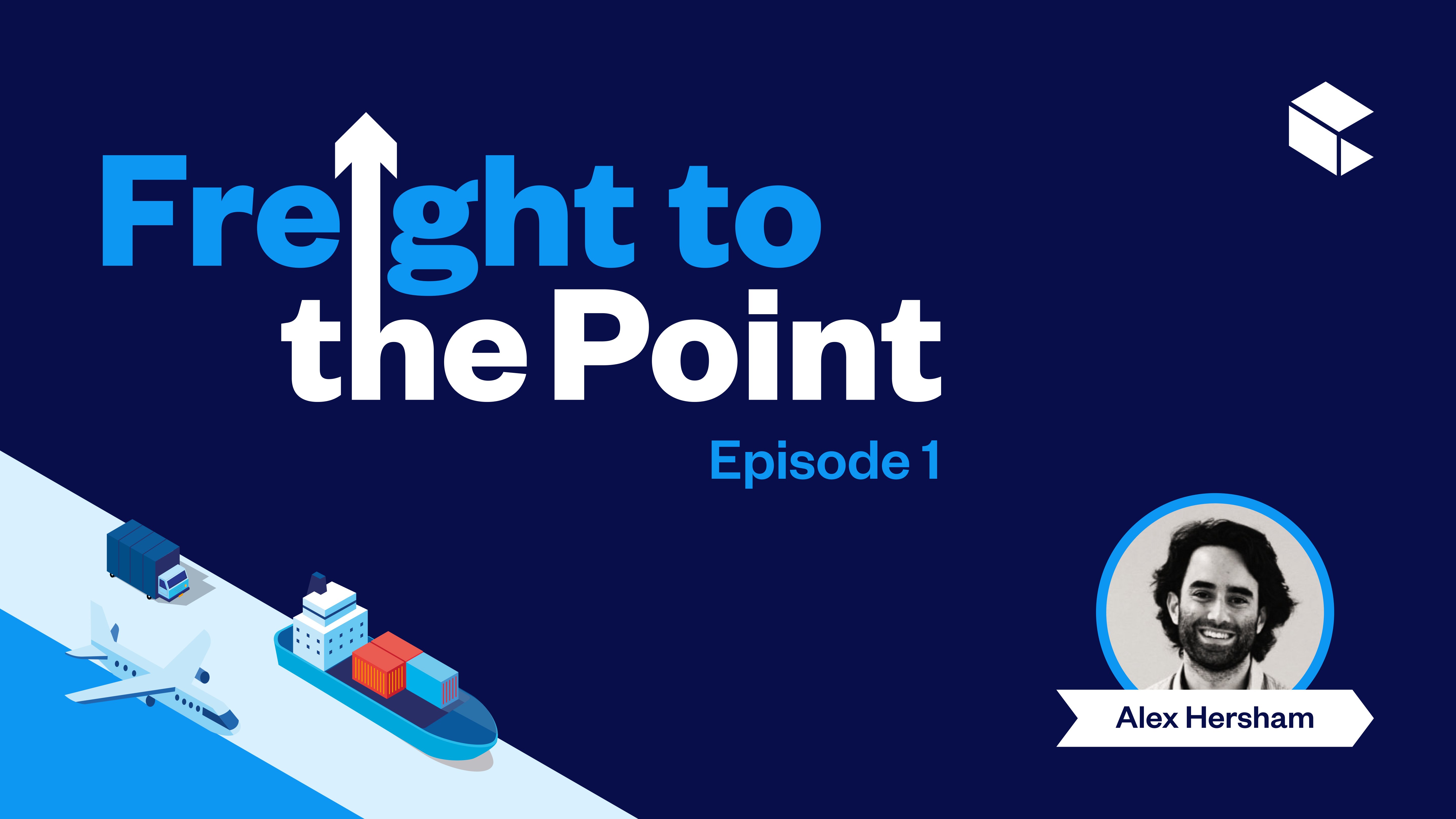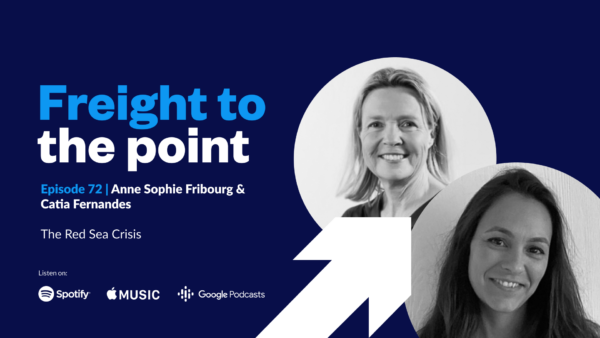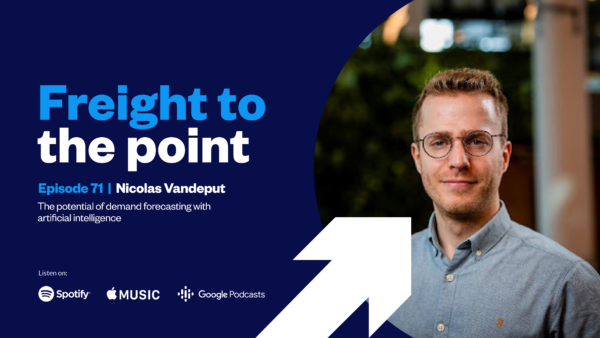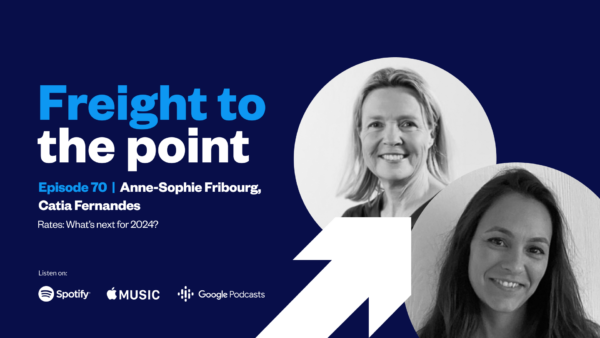Episode 1:
The Zencargo Co-Founder’s story by Alex Hersham
See all episodes

We’re kicking off the podcast series with Alex Hersham, CEO and Co-Founder of Zencargo. Since co-founding the company with Richard Fattal (CCO at Zencargo), the digital freight forwarding company has raised over $50 million and has grown to over 250 people worldwide.
He discusses:
- How he started Zencargo with his co-founder
- The journey Zencargo has been on and how the company has disrupted the industry
- And the three main accelerators he thinks will create change in the industry: Data, Revenue and Sustainability.
Alex Hersham, Co-Founder and CEO, Zencargo
Alex Hersham is Co-founder and CEO of Zencargo, the digital freight forwarder enabling organisations, from FTSE 100 businesses to fast-growing startups, to make smarter decisions through a real-time overview of their supply chain.
Listen to the next episode now
 Hello, and welcome to Freight to the Point, a podcast by Zencargo. Today is Episode One and I’m Helena Wood from Zencargo and I am so excited to kick off this podcast series with Alex Hersham, the CEO and co-founder of Zencargo. Today, we’re going to be talking about Alex’s origins, the inspiration behind setting up Zencargo, and how Alex thinks about the traditional industry and how disruption should come about in supply chain. Welcome, Alex.
Hello, and welcome to Freight to the Point, a podcast by Zencargo. Today is Episode One and I’m Helena Wood from Zencargo and I am so excited to kick off this podcast series with Alex Hersham, the CEO and co-founder of Zencargo. Today, we’re going to be talking about Alex’s origins, the inspiration behind setting up Zencargo, and how Alex thinks about the traditional industry and how disruption should come about in supply chain. Welcome, Alex.

 We could only start with you. So let’s get freight to the point. Tell us why you started Zencargo. Why supply chain?
We could only start with you. So let’s get freight to the point. Tell us why you started Zencargo. Why supply chain?
I fell in love with supply chain nearly a decade ago. I was building a business that was mostly an asset owning, so mostly owning traditional container ships. And we became a very large owner, actually. We became one of the largest beneficial owners of small to medium size container ships
And I fell in love, really, with how real supply chains are. It really allows you to understand international trade, understand how the world really works. From small things, like how does a container get stuff to origin? How does transport work? To the bigger things. How does the current environment, the current geopolitical environment feed into global trade? All of those things completely enamoured me.

 Oh, that sounds so exciting. And I can totally understand your kind of love for the, I’ve spoken about it before, but I think the magic of supply chain. I think when it’s an industry that you don’t work in… If I think about myself two years ago, not knowing anything really about supply chain, not having any sense of where my clothes or my iPhone or my water bottle comes from, and suddenly you open up this Pandora’s box of incredible systems, and multiple vendors and suppliers, and connected networks. It’s the most incredible logical puzzle that you can start to unwind.
Oh, that sounds so exciting. And I can totally understand your kind of love for the, I’ve spoken about it before, but I think the magic of supply chain. I think when it’s an industry that you don’t work in… If I think about myself two years ago, not knowing anything really about supply chain, not having any sense of where my clothes or my iPhone or my water bottle comes from, and suddenly you open up this Pandora’s box of incredible systems, and multiple vendors and suppliers, and connected networks. It’s the most incredible logical puzzle that you can start to unwind.
I could say that it started when we were 15 or 16, or I could say that it started when our parents were 20. It’s quite a funny story. So Richard and I became friends in our late teens, and we went to university together. Richard was always the smartest person I knew, and I was always just trying to focus on how do I get through the next exams. So it was a really nice compliment in terms of, essentially, me learning from him and him pretty much getting nothing out of that relationship. But it transpires that our parents were friendly when they were in their early twenties, and we have quite similar origins as well.
But it was really through university that we became super close. And we were constantly discussing through university, and actually ever since university, different business ideas, different things that we could do together, different ways of transforming industries. But it was only really the supply chain industry that we both felt a joint passion for.

 I can imagine. I’d love to have been a fly on the wall in some of those very early conversations as you rattled through ideas. What was it like in the early days? I remember you telling me about Zencargo’s origins in a coffee shop and really getting through the gritty startup story. Tell us a bit about that.
I can imagine. I’d love to have been a fly on the wall in some of those very early conversations as you rattled through ideas. What was it like in the early days? I remember you telling me about Zencargo’s origins in a coffee shop and really getting through the gritty startup story. Tell us a bit about that.
Yeah, so there was a coffee shop on Baker Street called The Koppel Project, and we would go there every morning. We would buy a coffee, we’d get there first in through the door because they had one or two lovely coworking desks. And we were very focused on just… We were completely committed to building Zencargo, and we were focused on just getting our first few customers, our first few hires and our first bit of code shipped. And then we did that all in a coffee shop, and we were really cost prudent and making sure that we got the basics in order first. And it was a lovely period of time.
We then moved to a small office, actually in the same building, just up a flight to stairs. Again, it was pretty cost conscious at the time. But it was a lovely atmosphere. Many of the people that were with us then, now five and a bit years ago, are still with us today. And we can share those fond memories of the early days at that coffee shop.

 I love that very literal journey of from coffee shop to first office, going up the stairs, not even leaving the building. And tell me, how many coffees is it appropriate to buy per staff member, per hour when you’re starting your business that’s doing the same thing?
I love that very literal journey of from coffee shop to first office, going up the stairs, not even leaving the building. And tell me, how many coffees is it appropriate to buy per staff member, per hour when you’re starting your business that’s doing the same thing?

 And tell me, how many coffees is it appropriate to buy per staff member, per hour when you’re starting your business?
And tell me, how many coffees is it appropriate to buy per staff member, per hour when you’re starting your business?

 Very good. Very good. I think I’d probably be more worried about straying to the cake counter actually, if I’d been there for too long.
Very good. Very good. I think I’d probably be more worried about straying to the cake counter actually, if I’d been there for too long.

 Zencargo sponsored by Julia, at The Koppel Project.So let’s talk more about the journey of Zencargo and the growth of the business. So I’d love to hear, from your perspective, Alex, we’ve gone through the journey of the offices and moving from the coffee shop, but when did it really start to feel real?’
Zencargo sponsored by Julia, at The Koppel Project.So let’s talk more about the journey of Zencargo and the growth of the business. So I’d love to hear, from your perspective, Alex, we’ve gone through the journey of the offices and moving from the coffee shop, but when did it really start to feel real?’
It felt real from day one, if I’m honest, because we were completely committed to building this business. And so from that perspective, the wall of stress and also joy in what you’re doing on a daily basis was there from day one. And so there was never really a point where it changed from that perspective.
When it started to really feel like we were doing something that was adding value to the ecosystem was probably about nine months in. So towards the late Q3, early Q4 of 2017. We had won various customers, but we started to really grow with some customers and really dig into their workflows and align what we’re building with how they thought about the world. And some of those customers had the problems that we really wanted to set out. They had more complex supply chains with distributed imagery. They had loads of manufacturers. They really cared about, I need SKU availability at my warehouse to hit revenue targets, but we have a cost focus. How do we balance those things?

 That’s fascinating. And was there anything that was surprising from those early customer relationships and interactions that maybe course corrected your thoughts at all?
That’s fascinating. And was there anything that was surprising from those early customer relationships and interactions that maybe course corrected your thoughts at all?
The thing with logistics, transportation and supply chains, generally, is sometimes you can be a bit of a kid in a candy store, because there are so many different types of companies that import in different ways, have different supply chains, run different products, and have different stresses or pain points within the supply chain that’s particularly acute to that type of customer. A company in, as an example, the diamond industry and the wood industry are extremely different, right? They’re different ends of the spectrum.

 Yeah. And I can understand that kid in a candy shop analogy because as we, I think we’re learning, your supply chain’s obviously so vast, so connected, there are so many players and there are so many problems, frankly, that businesses are looking to solve. I can imagine in those early days, the almost greedy appetite to want to tackle everything.
Yeah. And I can understand that kid in a candy shop analogy because as we, I think we’re learning, your supply chain’s obviously so vast, so connected, there are so many players and there are so many problems, frankly, that businesses are looking to solve. I can imagine in those early days, the almost greedy appetite to want to tackle everything.
So that was very much interlinked. We wanted to start initially with an instant pricing engine, that then allowed us to win business, create visibility, and then go back in the supply chain, do things like order management. And what we realized quite early on was that instant pricing is interesting, but really the type of customers that we were trying to work with wanted more strategic relationships. And so we very quickly said, “Okay, well, let’s go to the next step that we wanted to go to,” which was more origin and order management, SKU visibility. “Let’s start to build towards that earlier, rather than taking that first step in instant pricing.”.

 Because of course, in making that change, we were consciously deciding to focus on certain businesses and, therefore, not focus on other customers who might need to find help elsewhere. What tips would you have today for businesses that are maybe facing supply chain challenges that perhaps are not in verticals that supply chain, sorry, that Zencargo can help, or that are maybe a little bit smaller than the profile of customer that we work with today?
Because of course, in making that change, we were consciously deciding to focus on certain businesses and, therefore, not focus on other customers who might need to find help elsewhere. What tips would you have today for businesses that are maybe facing supply chain challenges that perhaps are not in verticals that supply chain, sorry, that Zencargo can help, or that are maybe a little bit smaller than the profile of customer that we work with today?
I think the basic tenants of find a partner that you want to work with and build a partnership, that doesn’t mean to everything through that partner, but build a partnership that’s in a mutual best interest, and try to work with a partner that has technology at their fingertips. Because the way that supply chains are evolving and, in particular, because of the chaos over the past two years, access to what’s really happening actually helps you move through the supply chain faster at a cheaper price. I can give various examples of how that is.

 That’s super interesting. And I’d love to then think more about the future of supply chain. If we think about those early days of building out that Zencargo product, building out the vision and everything being rooted in SKU-level visibility, excellent data, order management, it would be really interesting, Alex, to hear, building on those foundations, what is your vision of the future of supply chain and Zencargo’s place in that future?
That’s super interesting. And I’d love to then think more about the future of supply chain. If we think about those early days of building out that Zencargo product, building out the vision and everything being rooted in SKU-level visibility, excellent data, order management, it would be really interesting, Alex, to hear, building on those foundations, what is your vision of the future of supply chain and Zencargo’s place in that future?
So we talk a lot about a world with smarter trade. And for me, part of the future or part of what helps us build towards a world with smarter trade is the fact that we’re not the only people tackling challenges within supply chain. It’s actually really great to see that we can, in some parts, build on the shoulder of giants. We don’t have to go and build from scratch things that you wouldn’t expect us to build, like ERPs and CRMs. But also other parts of the supply chain that actually really needed transformation, whether that be on simple areas or seemingly simple areas, like schedules and tracking and IOT, where there’d be in other more complex domains, like customs, et cetera. They’re areas where we can really partner with companies, and they can be the best of that thin vertical slice.
And we can really be that single platform that the customer interacts with, that pulls the tracking information, pulls the SKU information, understands what’s happening through the supply chain, and most importantly, understands what you need to do with that information. If a SKU’s not going to arrive on time, or if an order is going to be early, how do you place that booking even faster, et cetera, so that you can move goods through the supply chain faster, cheaper. And then as we’ve spoken about a lot in a more environmentally friendly way through understanding your footprint, reducing your footprint, people talk a lot about offsetting, but reducing your footprint and then offsetting the residual.

 Thank you so much for sharing. It’s such an inspiring vision to think about that world of smarter trade and what that means not only for businesses and the businesses and customers that we work with, but also for their consumers and what that means for their own ability to impact, for example, and I’m going to pull out sustainable decision making.
Thank you so much for sharing. It’s such an inspiring vision to think about that world of smarter trade and what that means not only for businesses and the businesses and customers that we work with, but also for their consumers and what that means for their own ability to impact, for example, and I’m going to pull out sustainable decision making.
I think the role is similar to what it is today, but with an ability to do the things that drive more value more, right? A lot of the challenge within supply chain management, whether it’s logistics, warehousing, et cetera, is the fact that you have incredibly smart people who really know their domain extremely well and actually understand how their part of the puzzle feeds into the broader business in an exceptional way.
But you tend to get bogged down a lot with daily fires, daily escalations, things that you need to solve. And that crushes the mind space to really focus on how you develop, how you progress the supply chain and then yourself, professionally and personally.
And so for me, a big part of pulling data together, understanding what’s happening being more proactive rather than reactive gives you that space. And then working with the supply chain partner like Zencargo allows us to quarterly develop the supply chain, push it forward, make sure that we’re doing things that are driving value for the business while reducing the noise, reducing escalations, and allowing you to focus on the most important things.

 I think that’s such an exciting vision. And we’ve spoken before about the role of the chief supply chain officer, which some businesses are thinking about having that seat at the table for a senior supply chain leader and others are maybe on that journey and a bit further behind. But if we can really help the supply chain professionals of today and anyone who’s maybe even thinking about entering the industry build up that strategic know how, earn the right to have that seat at the table by empowering yourself with data, by being able to move from that reactive space into proactive. I think it just creates so much scope for a really rewarding and exciting experience for anyone working in the space.
I think that’s such an exciting vision. And we’ve spoken before about the role of the chief supply chain officer, which some businesses are thinking about having that seat at the table for a senior supply chain leader and others are maybe on that journey and a bit further behind. But if we can really help the supply chain professionals of today and anyone who’s maybe even thinking about entering the industry build up that strategic know how, earn the right to have that seat at the table by empowering yourself with data, by being able to move from that reactive space into proactive. I think it just creates so much scope for a really rewarding and exciting experience for anyone working in the space.

 It certainly sounds it. So one final question on the industry and disruption, and I’m going to put you on the spot, Alex, is where do you want to see change in the industry, and how would you like to drive that disruption?
It certainly sounds it. So one final question on the industry and disruption, and I’m going to put you on the spot, Alex, is where do you want to see change in the industry, and how would you like to drive that disruption?
I think there’s a few things. I think the first thing is if you go all the way to the consumer, if the consumer is empowered with understanding the footprint of the products that they’re buying and understanding the context of that. We understand it in calories today, we don’t really understand it in terms of footprints. I think that will have a huge impact on how everybody in the supply chain, our customers, us, the underlying transportation providers, manufacturers, how everybody thinks about and is incentivized to move forward at pace with, not just offsetting, but reducing emissions and reducing your overall footprint. So for me, that would be the first thing that I would love to see. It’s something that I think is very exciting. I do think it’s going to come. I think it’s a question of when. And hopefully there are businesses out there that will accelerate that trend. So we’re not waiting five years, but maybe we’re make we’re waiting 6, 12, 18 months. So that for me would be very much the first thing.
The second thing that I think businesses are doing and can do more of is standardize their data, standardize their product information, their product catalog. So many times we work with businesses, and we’re helping them on that journey, but they still have different information sources inside. And we see it all the time, obviously, because we are taking that SKU information, we’re then speaking to the manufacturer, and we can see those discrepancies. And smart decisions start with smart data in my world. And so creating that base, that foundation to build on, it will pull you away from the tactical. It will force you towards the strategic. I think that’s super valuable for businesses.

 Thank you for sharing that. And I love the structure of those three foundational pillars on which everyone can build, because actually I think that really does make things sound very, very accessible. And even though there’s lots of change to be made, quite a manageable starting point. Thank you.
Thank you for sharing that. And I love the structure of those three foundational pillars on which everyone can build, because actually I think that really does make things sound very, very accessible. And even though there’s lots of change to be made, quite a manageable starting point. Thank you.
Now, Alex, it’s time for this week’s quickfire questions. I hope you are comfortable and ready to fire through some big supply chain decisions to make nice and quickly.

 Cool. Question number one, which job in the supply chain space would you love to try for a day if you could do anything?
Cool. Question number one, which job in the supply chain space would you love to try for a day if you could do anything?

 Cool. Shout out to anyone that wants to get Alex into their intake warehouse.
Cool. Shout out to anyone that wants to get Alex into their intake warehouse.

 Okay. What’s the best career advice you’ve ever been given?
Okay. What’s the best career advice you’ve ever been given?

 Love that. And for anyone thinking about supply chain in their business right now, would you recommend they think about their short-term or their long-term strategy?
Love that. And for anyone thinking about supply chain in their business right now, would you recommend they think about their short-term or their long-term strategy?

 Perfect. And finally, tell us about a ship happens moment in your career.
Perfect. And finally, tell us about a ship happens moment in your career.

 I love that. Thank you so much, Alex. Well, it’s been such a pleasure to be joined by Alex Hersham, the CEO and co-founder of Zencargo, for our first episode of Freight to the Point. Alex, thank you so much for sharing your background and all of today’s insight.
I love that. Thank you so much, Alex. Well, it’s been such a pleasure to be joined by Alex Hersham, the CEO and co-founder of Zencargo, for our first episode of Freight to the Point. Alex, thank you so much for sharing your background and all of today’s insight.

 Huge thank you to our audience for tuning into this episode. If anyone has any questions or any feedback, please do contact us on LinkedIn. We’d absolutely love to hear from you, but for now, and until our next episode of Freight To The Point, goodbye.
Huge thank you to our audience for tuning into this episode. If anyone has any questions or any feedback, please do contact us on LinkedIn. We’d absolutely love to hear from you, but for now, and until our next episode of Freight To The Point, goodbye.

Episode 72: The Red Sea Crisis
In the latest episode of Freight to the Point, we’ve featured our most rec...

Episode 71: The potential of demand forecasting with artificial intelligence
In the most recent instalment of Freight to the Point, Lucie Phillips, Zen...

Episode 70: Rates: What's next for 2024?
As we prepare for the year ahead, it's crucial to consider the three pillars...

